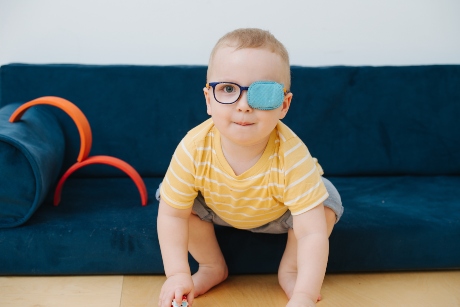
Understanding Lazy Eye
Posted February 22, 2021As a child develops, it is wonderful to watch them engage with the world around them. Everything is so new and exciting and they are constantly busy taking in new information. Sometimes, however, their eyes don’t develop properly. This can have long-lasting effects on their vision and it is essential to catch these issues as early as possible.
What is Lazy Eye
Amblyopia, or what is commonly known as lazy eye, is a medical condition that can occur during childhood. It involves one or (rarely) both eyes developing improperly. The eyes change quickly in early childhood and without treatment, the brain will learn to ignore the image transmitted by a weaker eye. This results in permanent vision problems.
Symptoms include:
-
Depth perception issues
-
Squinting/shutting one eye
-
Head tilting
-
Eye wandering inwards/outwards
-
Eyes not working together
Amblyopia rarely affects both eyes, since usually the brain relies on whichever eye projects the strongest message. This causes this eye to grow stronger. Sometimes a lazy eye is not evident without an exam. The most likely time for a child to develop this condition is between the ages of six and nine.
Causes/Risk Factors
The exact causes of amblyopia are not known. Doctors have noticed it can develop from other eye or vision problems such as strabismus, refractive errors, cloudiness, droopy eyelids, or cataracts.
Children are more likely to have a lazy eye if they were premature or small at birth, have a family history of lazy eye, or other developmental disabilities.
Early Diagnosis is Key
It is essential to diagnose a lazy eye as early as possible. Because everything is rapidly changing during this period of a child’s physical development, the eye can be trained out of weakness and the brain encouraged to accept information from that eye.
It is possible for you or your child not to notice any vision difficulties, so vision tests are imperative. Unless there is family history of amblyopia, optometrists recommend a vision check around a child’s fourth birthday.
Because poor vision in one eye may not always indicate a lazy eye, it is important for your doctor to conduct a complete exam as well as checking vision between the two eyes.
Treatment/Complications
The usual treatment for a lazy eye is to cover the stronger one with a patch. This forces the weaker one to work harder. Eyedrops can also be used to blur the stronger eye, as well as special eyeglasses.
Treatment usually lasts from several weeks to months, depending on the severity of the weakness. After that, the patch is usually only worn part-time for a few years. In children, treatment is often complete. However, teens and adults do not have the same physical dexterity and treatment may not be as successful. If amblyopia is not caught soon enough, there may be permanent vision loss.
If you notice your child exhibiting any of the above symptoms or they complain about their vision, set up an appointment with an optometrist. We are always happy to answer your questions! It is so important to us that we provide your little one with the most positive experience possible and you with the information that you need about their health. Make an appointment today!
